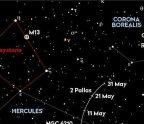ARTEMIS BEGINS

This year heralds the first crucial stage in NASA’s ambitious plans to put ‘boots back on the Moon’, as Artemis I gets ready for launch.
Artemis I is an uncrewed flight test of two new space systems: the world’s most powerful rocket – the Space Launch System – and the Orion crew spacecraft. It will travel to the Moon, skimming 100km above its surface before entering a retrograde orbit that takes it 70,000km beyond the lunar far side and returns to Earth 4-6 weeks later. Though it will have no human crew this time around, it will deploy multiple CubeSats to perform a range of science experiments.
Should all go well, Artemis II will take a four-person crew to lunar orbit and back no earlier than 2024. Finally, Artemis III aims to send astronauts to the lunar surface in 2025, with NASA vowing to put the first woman on the Moon and the first person of colour. Beyond this are plans for building the Lunar Gateway, a staging post in lunar orbit that will enable humans to stay at the Moon for months at a time. To learn more about the programme, we spoke to key figures across the Artemis project.


Orion’s first flight
The Orion module will house future crews reveals how Artemis I will put the new spacecraft through its paces
You’re reading a preview, subscribe to read more.
Start your free 30 days





